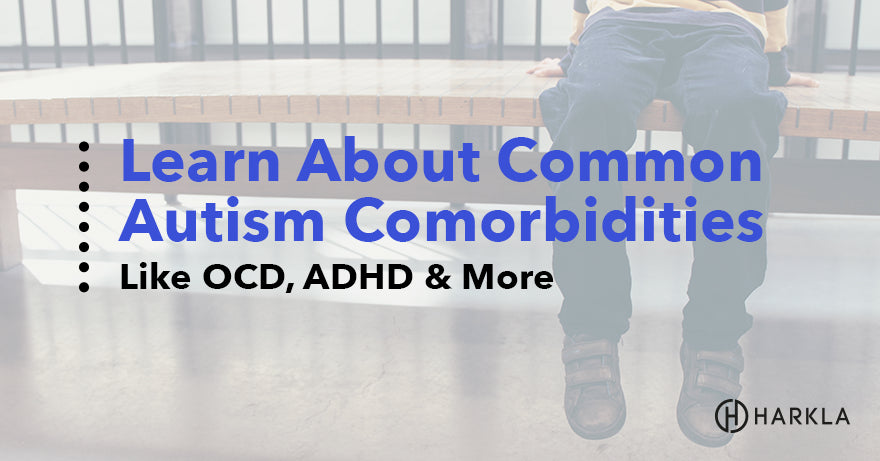Your Cart is Empty

In the United States, approximately 1 in 59 children have a diagnosis of autism spectrum disorder (ASD).
Autism is a disorder that can be classified by symptoms such as communication and language deficits, social skills problems, engaging in repetitive or stereotypical behaviors, learning difficulties, and behavioral issues. The type and severity of symptoms varies among individuals, with some experiencing severe symptoms, and others experiencing mild symptoms.
In addition to the core symptoms associated with autism, approximately ¾ of individuals with autism have at least one additional disorder. In fact, over half of those diagnosed with autism have four or more additional diagnosed disorders.

These additional diagnoses are referred to as comorbidities, as they occur in addition to autism. Some comorbidities may appear early on in life, while others will surface in adolescence or adulthood. A comorbid disorder can have an impact on a person’s response to autism therapies or treatments. Comorbid conditions also typically require some type of treatment, which is why they are crucial to recognize. In this article, we will review some of the most common autism comorbidities and discuss how they may affect the course of autism.
Obsessive Compulsive Disorder (OCD) is among the most common comorbidities with autism. It's associated with obsessions (thoughts) and compulsions (behaviors), which can become intrusive and impact a person’s daily living activities. The actual percentage of children with both autism and OCD is currently unknown, however, this is due to symptom overlap often making it hard to differentiate and confirm an OCD diagnosis. For example, a child with autism may become obsessive about playing with a certain toy or keeping objects lined up in a certain way. This may outwardly appear as OCD, however, these traits are also commonly associated with autism. Researchers believe there is likely only a small population of individuals with both autism and OCD and it is important to work with a trained professional to help with differentiating the two. Treatment for these disorders is vastly different. For example, OCD treatment focuses on conscious problem-solving to decrease unwanted thoughts and behaviors, while the treatment for autism is more focused on treating instinctual behaviors and sensory processing difficulties.
ADHD is one of the most commonly diagnosed mental health disorders in children. It is also more common in children with autism vs. the general population. About 30-60% of children with autism also have a diagnosis of ADHD. This overlap is often referred to as ADHD and autism comorbidity, since the two conditions frequently occur together. If you compare autism and ADHD, there are some overlaps in symptom presentation. For example, difficulty focusing, difficulty with communication, engaging in impulsive behavior, and trouble with schoolwork. One of the primary ways to diagnose ADHD is that the child will have difficulty with concentration, organization, impulsivity, and attention across settings. They will also likely avoid activities that require concentration or sustained effort. This can commonly co-occur with an autism diagnosis. Treatment for both ADHD and autism can also have some overlap. For example, occupational therapy is a common treatment for both, as sensory integration treatment can assist with ADHD and autism symptoms. There are other treatment options for ADHD, such as medication and behavioral therapy that may also be beneficial, so noticing ADHD symptoms is important.
Approximately 20-30% of individuals with ASD also have epilepsy or other seizure disorders. Seizures occur when abnormal electrical activity in the brain causes abnormal movement (convulsions) and sensations. During a seizure, there is typically a loss of consciousness. Many researchers believe there is a genetic link between ASD and seizures, however, more studies need to be completed to confirm this. Seizure disorders are generally treated with anti-epileptic medication. Seizures generally cannot be avoided, however ensuring a child is receiving adequate sleep and minimizing stress can help decrease their likelihood.
About 1 in 3 people with ASD also have a diagnosis of intellectual disability. An intellectual disability is defined as having an IQ lower than 70, which can be verified through psychological testing measures. Each individual with autism can be affected differently by an intellectual disability. For example, one individual may have severe cognitive deficits, while another may experience significant language delays, but have average cognitive abilities. Intellectual disabilities are typically believed to be the source of low adaptive functioning skills in children with autism. Adaptive skills involve the tasks needed to complete everyday tasks, such as personal care, managing money, organizing school and work tasks, seeking and maintaining employment, etc. Treatment for intellectual disabilities and autism typically involves occupational therapy, to help address functional life skills through skill modification, practice, and making adaptations to tasks as needed.
Bipolar Disorder is a mental health diagnosis classified by periods of mania (elevated mood and thoughts) and depression. There is some research to suggest that Bipolar is common in individuals with autism, however, it is difficult to conclude due to symptom overlap between the two diagnoses. Both autism and bipolar disorder can cause symptoms such as irritability, difficulty with emotion regulation, low energy level, impulsivity, social intrusiveness, etc. Because bipolar is often discussed among autism comorbidities, it is important to understand how symptoms overlap and differ. Bipolar disorder management typically involves the use of medication, however, some of these may be contraindicated for children with autism. Again, it is important for any child with a suspected comorbid condition to be assessed by a trained health professional in order to determine the best treatment.
It has been found that about 7% of children with autism and 26% of adults with autism are affected by depression. These rates increase as a person with autism ages and for those with autism and intellectual disability. Some signs of depression may include feeling hopeless or worthless, lack of interest in activities that were once enjoyable, low energy level, and feelings of sadness. Depression is a serious illness and if it is suspected, a medical or clinical professional should be involved right away. Individuals with autism commonly have trouble with personal insight, so they may not be able to identify these feelings in themselves. Therefore, it is important to be aware of these symptoms and intervene if necessary. Treatment for depression usually involves medication and cognitive behavioral therapy.
Generalized Anxiety Disorder can be classified by excessive worries or thoughts about a variety of things. Individuals with GAD find it difficult to control these worries and often expect the worst or unrealistically worry about a situation. Studies have shown that up to 42% of individuals with autism are affected by anxiety, compared to 3% of children and 15% of adults in the general population. People with autism typically exhibit fixation on specific thoughts or beliefs, however, if this continues to manifest with additional anxiety symptoms (racing heart, tense muscles, stomach pain, etc), it may be beneficial to seek help. Social anxiety is also highly linked to autism. Many individuals with autism find social situations to be anxiety-producing or may have certain sensory sensitivities that make social gatherings difficult to process. Medication and cognitive behavioral therapy are the primary treatment options for GAD, however, the appropriateness of these interventions for an individual with autism would need to be evaluated by a professional.
A recent study indicated that approximately 80% of young children with autism also experience sleep problems. Sleep problems are also twice as likely to occur in children with autism when compared to typically developing children. The most common sleep problem in individuals with autism is insomnia, or the ability to fall asleep and stay asleep. Some also experience sleep apnea, which is a condition that causes a person to stop breathing during periods of sleep. Because sleep disorders are among the most frequently reported autism comorbidities, they can have a profound impact on daily life. Individuals with autism are also more likely to get less restorative sleep, as they spend less time in REM (rapid-eye-movement sleep). REM sleep is critical for helping the brain store and retain information. Sleep disturbances can have a profound effect on an individual’s mood, ability to learn, and the ability to communicate and engage in proper social skills. These are also common issues for children with autism. It is difficult to determine if autism causes poor sleep or if poor sleep intensifies the symptoms of autism. Again, medication is sometimes used to address sleep disturbances for autism. In addition, occupational therapy can assist with sleep hygiene techniques and introducing potential sensory aids, such as a weighted blanket.
When compared to other children, children with autism experience more gastrointestinal disorders. It is estimated that GI disorders are 8 times more common in children with autism. This includes constipation, reflux, diarrhea, and abdominal pain. Studies have concluded that this is likely due to differences in diet (many individuals with autism eat a restricted diet), differences in gut bacteria found in the intestine, and stress experienced by individuals with autism. To address GI disorders, typically dietary restrictions or limitations are put into place. In addition, certain dietary supplements, such as Vitamin D may be helpful at managing GI disorders. Your child’s pediatrician is the best place to start when there are GI concerns or issues.

If you consider the prevalence rates, it is more than likely that an individual with autism will also have at least one diagnosable comorbid disorder. The effects of autism on an individual and their family can be profound and the addition of a comorbid diagnosis can feel daunting.
It is most important to work with a trained professional to assist with diagnosing any potential comorbid disorders. Your child’s pediatrician is a great place to start. In most instances, the symptom presentations of autism and many of the comorbid disorders can be difficult or impossible to differentiate from one another. However, most symptoms associated with comorbid disorders have promising and validated treatment options. We hope that this article highlighted the most common autism comorbidities and provided you with valuable information regarding symptoms so that you can seek additional services for your child if needed.
References
Tye, C. et al. (2019). Characterizing the interplay between autism spectrum disorder and comorbid medical conditions: An integrative review. Frontiers in Psychiatry, 10, 438-450.
Zafeiriou, D.I., Ververi, A., & Vargiami, E. Childhood autism and associated comorbidities. Brain and Development, 29 (5), 257-272.
Thank you fot this very informative information, my granddaughter has been diagnosed with autism and ADHD. Marley is 5 yrs old she was diagnosed at 4, she was showing symptoms since birth but we were unaware, my daughter still struggles with the diagnosis, which leaves me being the primary care for Marley’s behavior and advocating for her needs that’s why l appreciate articles like this again l thank you.
Comments will be approved before showing up.


Lisa
February 08, 2022
We have sleep problems but also have sensory processing disorder and possible PDA (pathological demand avoidance) again both I would say highly common comorbidity